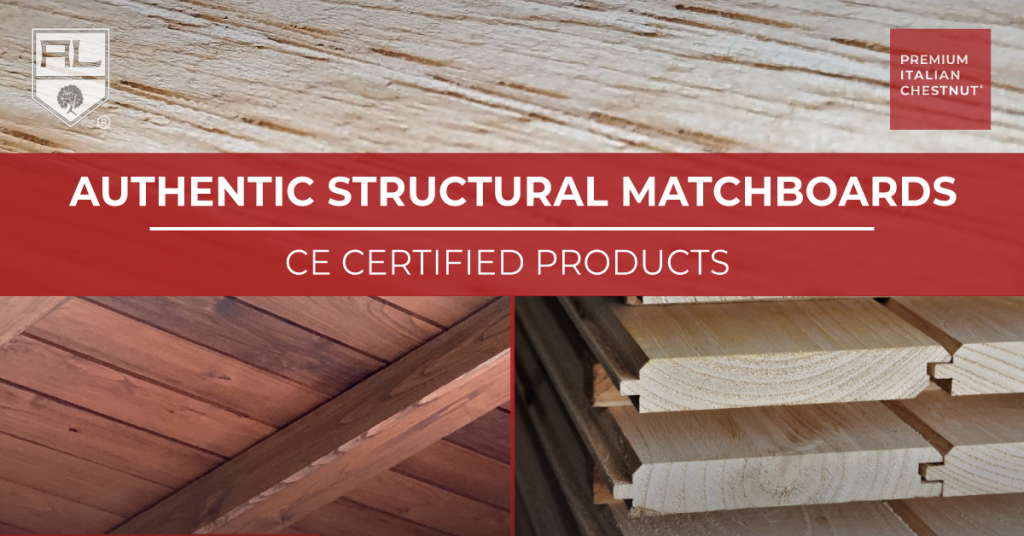
“CE” MARKING CHESTNUT MATCHBOARDS
It is official now, Artena Legnami obtains the CE certification for chestnut matchboards, or better say ”solid chestnut wood boards for flatwise structural use with overlapping edge profiles” (ETA 20/1323).
Our company is one of the first in Italy and in Europe to receive this type of recognition. An innovative certification of international importance, a mark that proves authenticity, quality, origin and efficiency of our products.
Compared to the previous certification (ETA 18/0288), the novelty is in the possibility of marking the matchboard produced in chestnut wood. This is an important result and great pride for all of us, especially because a great contribution to the project comes from our company: our own Guglielmo Lanna who is an expert in this sector, observer on the Assolegno Council and member of the Conlegno Technical Committee, has always been one of the main supporters of this project, collaborating with great passion in its conception, development and implementation.
What does CE certification carry?
As it is widely illustrated elsewhere, defining the quality of a material or a product is never simple. The intercession of CE certification, like the one mentioned above, in addition to assessing the consistency of performance and factory production control (in accordance with the requirements), opens up a number of benefits. Without doubts, in the two-year period 2018-2019, the entry on the international scene of the BM Trada Technical Assessment Organization was decisive, through which Italian companies – the first on the continental scene – can produce and CE mark matchboards for structural use, enjoying an exclusive competitive advantage on the market.
As noted on Conlegno’s portal, in section ‘Structural Wood’, “ETA is now the only way to be able to CE mark the matchboards for structural use because, as provided by UNI EN 14081-1 (“Structural wood with rectangular section classified according to the resistance – general requirements”), following the processing undergone to confer the specific profile the starting boards lose the class of resistance. It should be added – it concludes – that this assortment is increasingly requested by private and public customers; it is therefore an important and unmissable opportunity, both at technical and commercial level, which allows only certain companies to be able to provide the market with a product that complies with the Technical Standards for Construction so to affix the CE mark for structural purposes”.
Through the certificate issued by CSI – IMQ Group company classifiable among the top international leaders in the activity of verification of conformity – it is possible, finally, to highlight how ETA offers the possibility to CE mark structural matchboards from conifers and broadleaf trees with thicknesses starting from 18mm and width from 80mm.

The use of structural matchboard: focus on attics and wall coverings
In the building sector, the matchboard, which is a term used to indicate a board of planed wood, with variable thickness and length, depending on the cases, is generally used in the construction of attics, ceilings, loft planks, floors and coatings, both external and internal; the lateral overlapping edges are characterized by two different shapes, called respectively tongue and groove (similar to “male” and “female” which are slang-terms from other countries) can be customized according to different tastes and needs.
About the use of the matchboards for attics, they are components from secondary roof frames together with laths and counter laths. In other contexts, the matchboards can also be applied as a wall covering, opting for different laying methods:
- Planking laying: boards placed one on top of other vertically pieces.
- Shingle laying: slightly inclined (the upper one overlaps externally on the lower one).
- Groove and relief laying: two boards are placed side by side and serve as a base for a third board which is positioned in the middle, above the other two.
More than elegant
In terms of design, the matchboarding embellishes the environment making it pleasant and elegant: it gives a harmonious touch to the structure through the various and possible forms of arrangement: horizontal (boards which are arranged parallel to the floor), vertical (arranged so perpendicular to the floor), oblique (inclined at an angle of 45 degrees) and baseboard (perpendicular to the floor but ending in the middle of the wall against a wooden baseboard).
The versatility of the matchboarding allows, moreover, the creation of structural and furnishing components that can integrate wonderfully with other elements, giving rise to extraordinarily impactful aesthetic results.
In short, the adoption of ETA 18/0288 testifies to Artena Legnami’s strong focus both on innovation and on the continuous search for (and offer of) an excellent product which can be certified, traced and compliant with the strict EU regulations: a perspective , moreover, of combining health and environmental safety – guaranteed by the CE mark – with the development of the Italian structural wood industry.
Click HERE to check all our certifications or HERE to learn more about our Premium Italian Chestnut®. Also, follow us on our Facebook and Instagram pages for news and insights on the Chestnut Culture.
Don’t miss our other publications:
CHESTNUT STYLE – CLASSICAL, RUSTIC, MODERN.
50 SHADES OF CHESTNUT
THE 5 PILLARS OF SUSTAINABILITY – PEFC
CE MARKING CHESTNUT TIMBER
7 REASONS TO CHOOSE SOLID CHESTNUT



